Shedding Light on the Effects of Orienteering Exercise on Spatial Memory Performance in College Students of Different Genders: An fNIRS Study
Abstract
1. Introduction
2. Materials and Methods
2.1. Participants
2.2. Experimental Design
2.3. Orienteering Intervention Program
2.4. Spatial Memory Task Test
2.4.1. Experimental Instruments
2.4.2. Test Materials
2.4.3. Testing Process
2.5. Probe Arrangement
2.6. Data Analysis
2.6.1. Behavioral Data
2.6.2. fNIRS Data
3. Results
3.1. Behavioral Results
3.1.1. Behavioral Results of Different Groups before and after Exercise Intervention
3.1.2. Behavioral Results of Spatial Memory Ability of College Students of Different Genders in the Experimental Group before and after the Intervention
3.2. fNIRS Results
3.2.1. fNIRS Results of Different Groups before and after Exercise Intervention
3.2.2. Behavioral Results of Spatial Memory Ability of College Students of Different Genders in the Experimental Group before and after the Intervention
3.3. Results of Correlation Analysis between Cerebral Blood Oxygen Activation and Correct Rate
3.4. Analysis of Functional Connectivity Results between Brain Regions
4. Discussion
4.1. Analysis and Discussion of Behavioral Results
4.2. Analysis and Discussion of fNIRS Results
5. Conclusions
Supplementary Materials
Author Contributions
Funding
Institutional Review Board Statement
Informed Consent Statement
Data Availability Statement
Acknowledgments
Conflicts of Interest
References
- Adam, W.L. The Aging Navigational System. Neuron 2017, 95, 1019–1035. [Google Scholar]
- Tolman, E.C. Cognitive maps in rats and men. Psychol. Rev. 1948, 55, 189–208. [Google Scholar] [CrossRef] [PubMed]
- Gursky, Z.H.; Savage, L.M.; Klintsova, A.Y. Executive functioning-specific behavioral impairments in a rat model of human third trimester binge drinking implicate prefrontal thalamo hippocampal circuitry in Fetal Alcohol Spectrum Disorders. Behav. Brain Res. 2021, 405, 113208. [Google Scholar] [CrossRef] [PubMed]
- McGaugh, J.L. Time-dependent processes in memory storage. Science 1966, 153, 1351–1358. [Google Scholar] [CrossRef]
- Chun, M.M.; Jiang, Y. Contextual cueing: Implicit learning and memory of visual context guides spatial attention. Cogn. Psychol. 1998, 36, 28–71. [Google Scholar] [CrossRef]
- Panico, F.; Marco, S.D.; Sagliano, L.; D’Olimpio, F.; Trojano, L. Brain hemodynamic response in Examiner-Examinee dyads during spatial short-term memory task: An fNIRS study. Exp. Brain Res. 2021, 239, 1607–1616. [Google Scholar] [CrossRef]
- Geissler, C.F.; Gregor, D.; Christian, F. Shedding light on the frontal hemodynamics of spatial working memory using functional near-infrared spectroscopy. Neuropsychologia 2020, 146, 107–570. [Google Scholar] [CrossRef]
- McKendrick, R.; Harwood, A. Cognitive Workload and Workload Transitions Elicit Curvilinear Hemodynamics during Spatial Working Memory. Front. Hum. Neurosci. 2019, 13, 405. [Google Scholar] [CrossRef]
- Frias, D.C.; Nilsson, L.G.; Herlitz, A. Sex differences in cognition are stable over a 10-year period in adulthood and old age. Neuropsychol. Cogn. 2016, 6, 574–587. [Google Scholar] [CrossRef]
- Sarit, S.; Sarit, A. The Unique Role of Spatial Working Memory for Mathematics Performance. J. Numer. Cogn. 2022, 8, 226–243. [Google Scholar]
- Munion, A.K.; Stefanucci, J.K.; Rovira, E.; Squire, P.; Hendricks, M. Gender differences in spatial navigation: Characterizing wayfinding behaviors. Psychon. Bull. Rev. 2019, 26, 1933–1940. [Google Scholar] [CrossRef] [PubMed]
- Weiss, E.M.; Kemmler, G.; Deisenhammer, E.A.; Fleischhacker, W.W.; Delazer, M. Sex differences in cognitive functions. Personal. Individ. Differ. 2003, 35, 863–875. [Google Scholar] [CrossRef]
- Mueller, S.C.; Carl, P.T.; Jackson, R.W. Sex differences in a virtual water maze: An eye tracking and pupillometry study. Behav. Brain Res. 2008, 193, 209–215. [Google Scholar] [CrossRef]
- Daniel, G.W.; Ben, V.; Hans, O.B.; Johan, W.; Lse, G.; Rudi, D.H.; Swinnen, S.P.; Nicole, W. Sex differences in human virtual water maze performance: Novel measures reveal the relative contribution of directional responding and spatial knowledge. Behav. Brain Res. 2009, 208, 408–414. [Google Scholar]
- Rizk-Jackson, A.M.; Acevedo, S.F.; Inman, D.; Howieson, D.; Benice, T.S.; Raber, J. Effects of sex on object recognition and spatial navigation in humans. Behav. Brain Res. 2006, 173, 181–190. [Google Scholar] [CrossRef] [PubMed]
- Head, D.; Isom, M. Age effects on wayfinding and route learning skills. Behav. Brain Res. 2010, 209, 49–58. [Google Scholar] [CrossRef] [PubMed]
- Kessels, R.P.C.; Nys, G.M.S.; Brands, A.M.A.; Berg, E.V.D.; Van Zandvoort, M.J.E. The modified Location Learning Test: Norms for the assessment of spatial memory function in neuropsychological patients. Arch. Clin. Neuropsychol. 2006, 21, 841–846. [Google Scholar] [CrossRef]
- Álvarez, B.C.; Hillman, C.H.; Cavero, R.I.; Sánchez, L.M.; Pozuelo, D.P.; Martínez, V.V. Aerobic fitness and academic achievement: A systematic review and meta-analysis. J. Sports Sci. 2020, 38, 582–589. [Google Scholar] [CrossRef]
- Chaddock, H.L.; Weng, T.B.; Kienzler, C.; Weisshappel, R.; Drollette, E.S.; Raine, L.B.; Westfall, D.R.; Kao, S.C.; Baniqued, P.; Castelli, M.D.; et al. Brain Network Modularity Predicts Improvements in Cognitive and Scholastic Performance in Children Involved in a Physical Activity Intervention. Front. Hum. Neurosci. 2020, 34, 346. [Google Scholar] [CrossRef]
- Wang, X.Q.; Wang, G.W. Effects of treadmill exercise intensity on spatial working memory and long-term memory in rats. Life Sci. 2016, 149, 96–103. [Google Scholar] [CrossRef]
- Frith, E.; Sng, E.; Loprinzi, P.D. Randomized controlled trial evaluating the temporal effects of high-intensity exercise on learning, short-term and long-term memory, and prospective memory. Eur. J. Neurosci. 2017, 46, 2557–2564. [Google Scholar] [CrossRef] [PubMed]
- Cassilhas, R.; Tufik, S.; Mello, M. Physical exercise, neuroplasticity, spatial learning and memory. Cell. Mol. Life Sci. 2015, 73, 1–9. [Google Scholar] [CrossRef] [PubMed]
- Zheng, G.; Xia, R.; Zhou, W.; Tao, J.; Chen, L. Aerobic exercise ameliorates cognitive function in older adults with mild cognitive impairment: A systematic review and meta-analysis of randomised controlled trials. Br. J. Sports Med. 2016, 50, 1443–1450. [Google Scholar] [CrossRef] [PubMed]
- Stroth, S.; Hille, K.; Spitzer, M.; Reinhardt, R. Aerobic endurance exercise benefits memory and affect in young adults. Neuropsychol. Rehabil. 2009, 19, 223–243. [Google Scholar] [CrossRef]
- Lipsky, R.H.; Marini, A.M. Brain derived neurotrophic factor in neuronal survival and behavior related plasticity. Ann. N. Y. Acad. Sci. 2007, 1122, 130–143. [Google Scholar] [CrossRef]
- Cowansage, K.K.; Ledoux, J.E.; Monfils, M. Brain derived neurotrophic factor: A dynamic gatekeeper of neural plasticity. Curr. Mol. Pharm. 2010, 3, 12–29. [Google Scholar] [CrossRef]
- Ronca, F.; Crum, J.; Jones, I.; Hirsch, J.; Hamilton, A.; Tachtsidis, I.; Burgess, P. Extensive Prefrontal Cortex Haemodynamic Changes Provoked by Intense Aerobic Exercise, Measured via FNIRS: 958. Med. Sci. Sports Exerc. 2021, 53, 315–316. [Google Scholar] [CrossRef]
- Wang, C.-H.; Moreau, D.; Yang, C.-T.; Tsai, Y.-Y.; Lin, J.-T. Aerobic exercise modulates transfer and brain signal complexity following cognitive training. Biol. Psychol. 2019, 144, 85–98. [Google Scholar] [CrossRef]
- Voss, M.W.; Vivar, C.; Kramer, A.F. Bridging animal and human models of exercise-induced brain plasticity. Trends Cogn. Sci. 2013, 17, 525–544. [Google Scholar] [CrossRef]
- Chirles, T.J.; Reiter, K.; Weiss, L.R. Exercise training and functional connectivity changes in mild cognitive impairment and healthy elders. J. Alzheimer’s Dis. 2017, 57, 845–856. [Google Scholar] [CrossRef]
- Rajab, A.S.; Crane, D.E.; Middleton, L.E. A single session of exercise increases connectivity in sensorimotor-related brain networks:A resting-state fMRI study in young healthy adults. Front. Hum. Neurosci. 2014, 8, 625. [Google Scholar] [CrossRef] [PubMed]
- Wayne, W. Thought in Action: Expertise and the Conscious Mind, Barbara Gail Montero. Australas. J. Philos. 2018, 96, 408–410. [Google Scholar]
- Song, Y.; Tang, S.; Xian, H. A study on the effect of mental rotation ability on the map recognition efficiency of orienteering players. J. Sports 2021, 28, 125–130. [Google Scholar]
- Liu, Y. Visual search characteristics of precise map reading by orienteers. Peerj 2019, 23, e7592–e7605. [Google Scholar] [CrossRef]
- Eccles, D.W.; Walsh, S.E.; Ingledew, D.K. The use of heuristics during route planning by expert and novice orienteers. J. Sports Sci. 2002, 20, 327–337. [Google Scholar] [CrossRef]
- Bayta, E.; Tokta, N.; Sahan, A. Multiple Intelligence Profiles According to Chronotype in Orienteering Athletes. In Proceedings of the World Congress of Sport Sciences Researches, Manisa, Turkey, 23–26 November 2017. [Google Scholar]
- Yang, Y.; Chen, T.; Shao, M. Effects of Tai Chi Chuan on Inhibitory Control in Elderly Women: An fNIRS Study. Front. Hum. Neurosci. 2019, 22, 1–11. [Google Scholar] [CrossRef]
- Carius, D.; Kenville, R.; Maudrich, D. Cortical processing during table tennis-an fNIRS study in experts and novices. Eur. J. Sport Sci. 2021, 17, 21–26. [Google Scholar] [CrossRef]
- Mucke, M.; Ludyga, S.; Colledge, F. The Influence of an Acute Exercise Bout on Adolescents’ Stress Reactivity, Interference Control and Brain Oxygenation Under Stress. Neurorehabilit. Neural Repair 2020, 10, 581965–581978. [Google Scholar] [CrossRef]
- Parsons, O.A.; Nixon, S.J. Neurobehavioral sequelae of alcoholish. Neurol. Clin. 1993, 11, 205–218. [Google Scholar] [CrossRef]
- Squire, L.R. The neuropsychology of human memory. Annu. Rev. Neurosci. 1982, 5, 241–273. [Google Scholar] [CrossRef]
- Robert, J.S.; Tirin, M. Selective Attention from Voluntary Control of Neurons in Prefrontal Cortex. Science 2011, 332, 1568–1571. [Google Scholar]
- Mary, H.; Anthony, E.R.; Daniel, R.M. Development of a self-report measure of environmental spatial ability. Intelligence 2002, 30, 25–447. [Google Scholar]
- Zhao, Y. The Relationship between Path Strategy and Spatial Navigation and the Influencing Factors of Pathfinding Strategy. Master’s Thesis, Northeast Normal University, Changchun, China, 2021. [Google Scholar]
- Fan, Y.C.; Yan, Q.; Li, M. Study on the effect of 4-week high-intensity interval training on the improvement of special athletic ability of excellent synchronized swimmers. Chin. Sports Sci. Technol. 2019, 55, 60–63+107. [Google Scholar]
- Tanaka, H.; Monahan, K.D.; Seals, D.R. Age-predicted maximal heart rate revisited. J. Am. Coll. Cardiol. 2001, 37, 153–156. [Google Scholar] [CrossRef]
- Delpy, D.T.; Cope, M.; Zee, P. Estimation of optical pathlength through tissue from direct time of flight measurement. Phys. Med. Biol. 1988, 33, 1433–1442. [Google Scholar] [CrossRef]
- Schroeter, M.L.; Stefan, Z.; Wahl, M.; Cramon, D.Y.V. Prefrontal activation due to Stroop interference increases during development an event related fNIRS study. Neuroimage 2004, 23, 1317–1325. [Google Scholar] [CrossRef]
- Sperling, G. The information available in brief visual presentations. Psychol. Monogr. Gen. Appl. 1960, 74, 1–29. [Google Scholar] [CrossRef]
- Vogel, E.K.; Machizawa, M.G. Neural activity predicts individual differences in visual working memory capacity. Nature 2004, 42, 748–751. [Google Scholar] [CrossRef]
- Zhu, X.; Wang, J.; Li, X. The role of visuospatial working memory and nonverbal fluid intelligence in elementary school students’ problem solving in mathematics. Psychol. Sci. 2011, 34, 845–851. [Google Scholar]
- Pio, A.T.; Felice, C.; Maurizio, S. Orienteering: Spatial navigation strategies and cognitive processes. J. Hum. Sport Exerc. 2015, 10, 507–514. [Google Scholar]
- Liu, J. An Experimental Study of Emotion and Visuospatial Working Memory on Cognitive Decision Making in Orienting Map Recognition. Master’s Thesis, Shandong Normal University, Shandong, China, 2021. [Google Scholar]
- Xie, S.; Gong, B.; Tao, R. Application and inspiration of deliberate training theory in the development of soccer reserve talents in England. J. Sports 2020, 27, 132–138. [Google Scholar]
- Lunze, J. Psychological information acceptance and information reproduction abilities of orienteer’s. Sci. J. Orienteer 1987, 3, 52–63. [Google Scholar]
- Zilles, D. Gender Differences in Verbal and Visuospatial Working Memory Performance and Networks. Neuropsychobiology 2016, 73, 52–63. [Google Scholar] [CrossRef]
- Nori, R.; Piccardi, L.; Migliori, M.; Guidazzoli, A.; Frasca, F.; de Luca, D.; Giusberti, F. The virtual reality Walking Corsi Test. Comput. Hum. Behav. 2015, 48, 72–77. [Google Scholar] [CrossRef]
- Emanuele, C.; Giorgia, L. Gender differences in spatial orientation: A review. J. Environ. Psychol. 2004, 24, 329–340. [Google Scholar]
- Olesen, P.J.; Westerberg, H.; Klingberg, T. Increased prefrontal and parietal activity after training of working memory. Nat. Neurosci. 2004, 7, 75–79. [Google Scholar] [CrossRef]
- Vermeij, A. Prefrontal activation may predict working-memory training gain in normal aging and mild cognitive impairment. Brain Imaging Behav. 2017, 11, 141–154. [Google Scholar] [CrossRef] [PubMed]
- Raja, P. Putting the Brain to Work: Neuroergonomics Past, Present, and Future. Hum. Factors 2008, 50, 468–474. [Google Scholar]
- Haxby, J.V.; Ungerleider, L.G.; Horwitz, B.R.S.; Grady, C.L. Hemispheric differences in neural systems for face working memory: A PET-rCBF study. Hum. Brain Mapp. 1995, 3, 68–82. [Google Scholar] [CrossRef]
- Wilson, G.D.; Mitche, L.A.S. Neurotoxic lesions of ventrolateral prefrontal cortex impair object-in-place scene memory. Eur. J. Neurosci. 2007, 25, 2514–2522. [Google Scholar] [CrossRef]
- Cao, W. Effects of Cognitive Training on Resting-State Functional Connectivity of Default Mode, Salience, and Central Executive Networks. Front. Aging Neurosci. 2016, 8, 70. [Google Scholar] [CrossRef] [PubMed]
- Yamazaki, Y. Inter-individual Differences in Exercise-Induced Spatial Working Memory Improvement: A Near-Infrared Spectroscopy Study. Adv. Exp. Med. Biol. 2017, 977, 81–88. [Google Scholar] [PubMed]
- Mou, W.M.; Zhao, M.T.; Li, X.O. Human spatial memory and spatial cruising. Adv. Psychol. Sci. 2006, 14, 497–504. [Google Scholar]
- Braver, T.S.; Cohen, J.D.; Nystrom, L.E. A parametric study of prefrontal cortex involvement in human working memory. Neuroimage 1997, 5, 49–62. [Google Scholar] [CrossRef]
- D’Esposito, M.; Ballard, D.; Zarahn, E. The role of prefrontal cortex in sensory memory and motor preparation: An event-related fMRI study. Neuroimage 2000, 11, 400–408. [Google Scholar] [CrossRef] [PubMed][Green Version]
- Earl, K.M.; Jonathan, D.C. An integrative theory of prefrontal cortex function. Annu. Rev. Neurosci. 2001, 24, 167–202. [Google Scholar]
- Cieslik, E.C.; Zilles, K.; Caspers, S. Is there “one” DLPFC in cognitive action control? Evidence for heterogeneity from coactivation based parcellation. Cerebralcortex 2013, 23, 2677–2689. [Google Scholar]
- Yarkoni, T.; Poldrack, R.A.; Nichols, T.E. Large-scale automated synthesis of human functional neuroimaging data. Nat. Methods 2011, 8, 665–670. [Google Scholar] [CrossRef] [PubMed]
- Aljoscha, C. Neubauer and Andreas Fink. Intelligence and neural efficiency. Neurosci. Biobehav. Rev. 2009, 33, 1004–1023. [Google Scholar]
- Sebastian, E.W. Winning the game: Brain processes in expert, young elite and amateur table tennis players. Front. Behav. Neurosci. 2014, 8, 370. [Google Scholar]
- Sebastian, W. Motor skill failure or flow-experience? Functional brain asymmetry and brain connectivity in elite and amateur table tennis players. Biol. Psychol. 2015, 105, 95–105. [Google Scholar]
- Marcel, A.; Reus, D.; Martijn, P.; Heuvel, V.D. Rich club organization and intermodule communication in the cat connectome. J. Neurosci. 2013, 33, 12929–12939. [Google Scholar]
- Hoff, G.E.; Anna, J. On development of functional brain connectivity in the young brain. Front. Hum. Neurosci. 2013, 7, 650. [Google Scholar] [CrossRef] [PubMed]
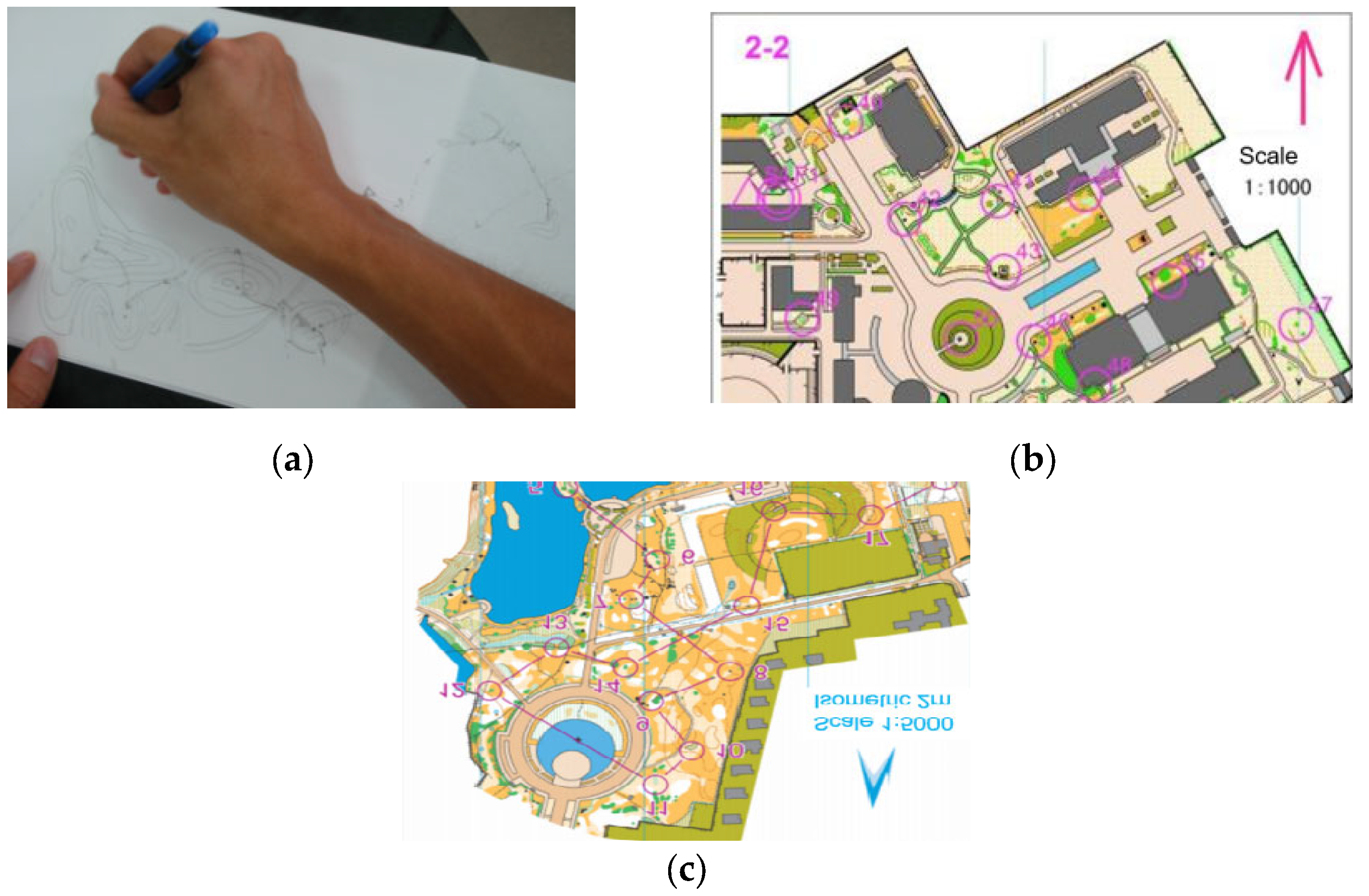
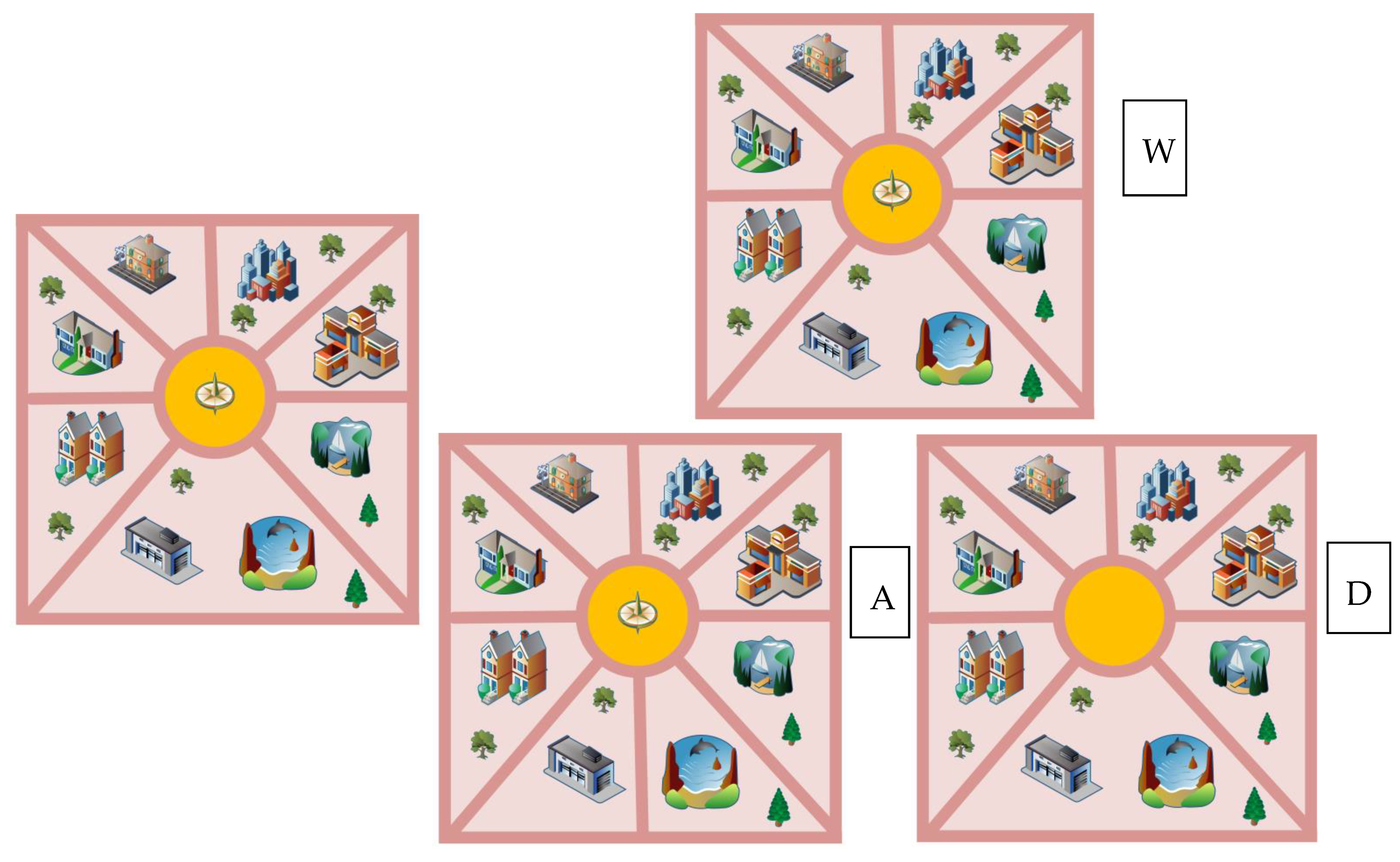


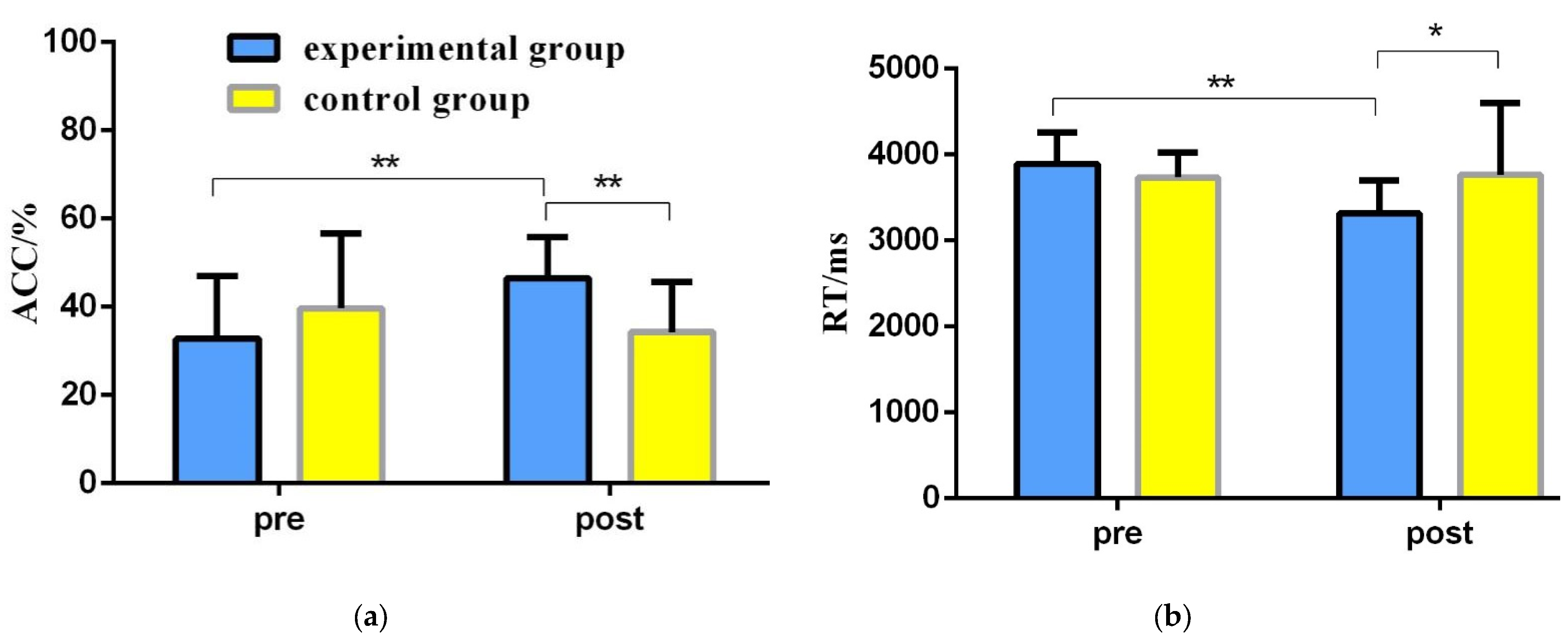


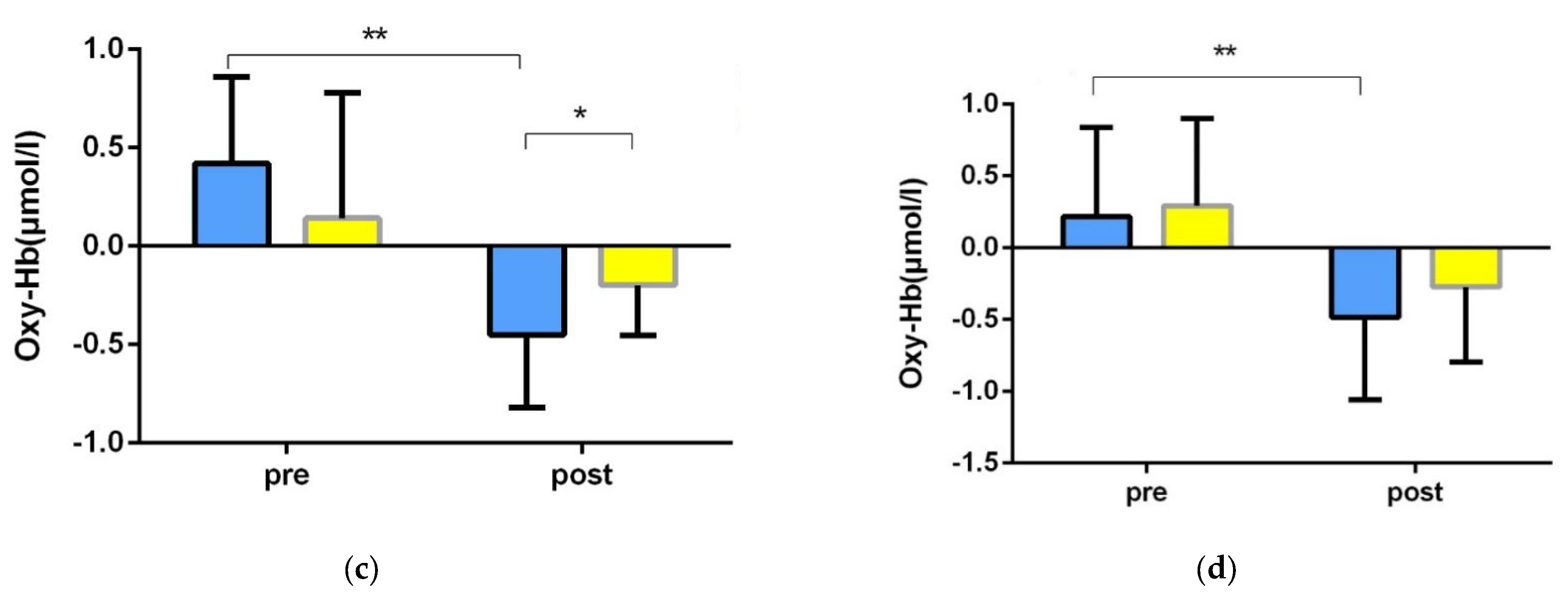


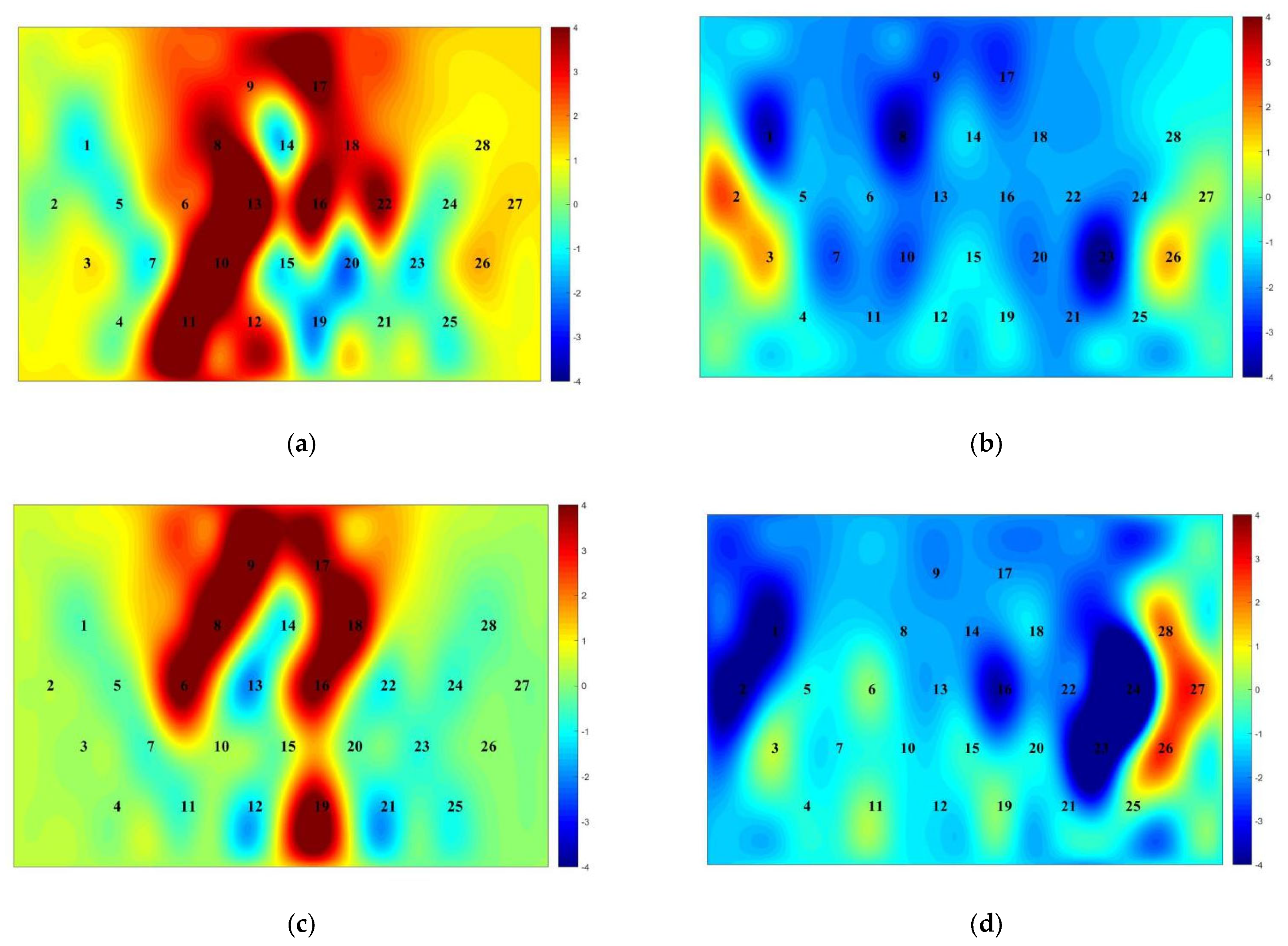

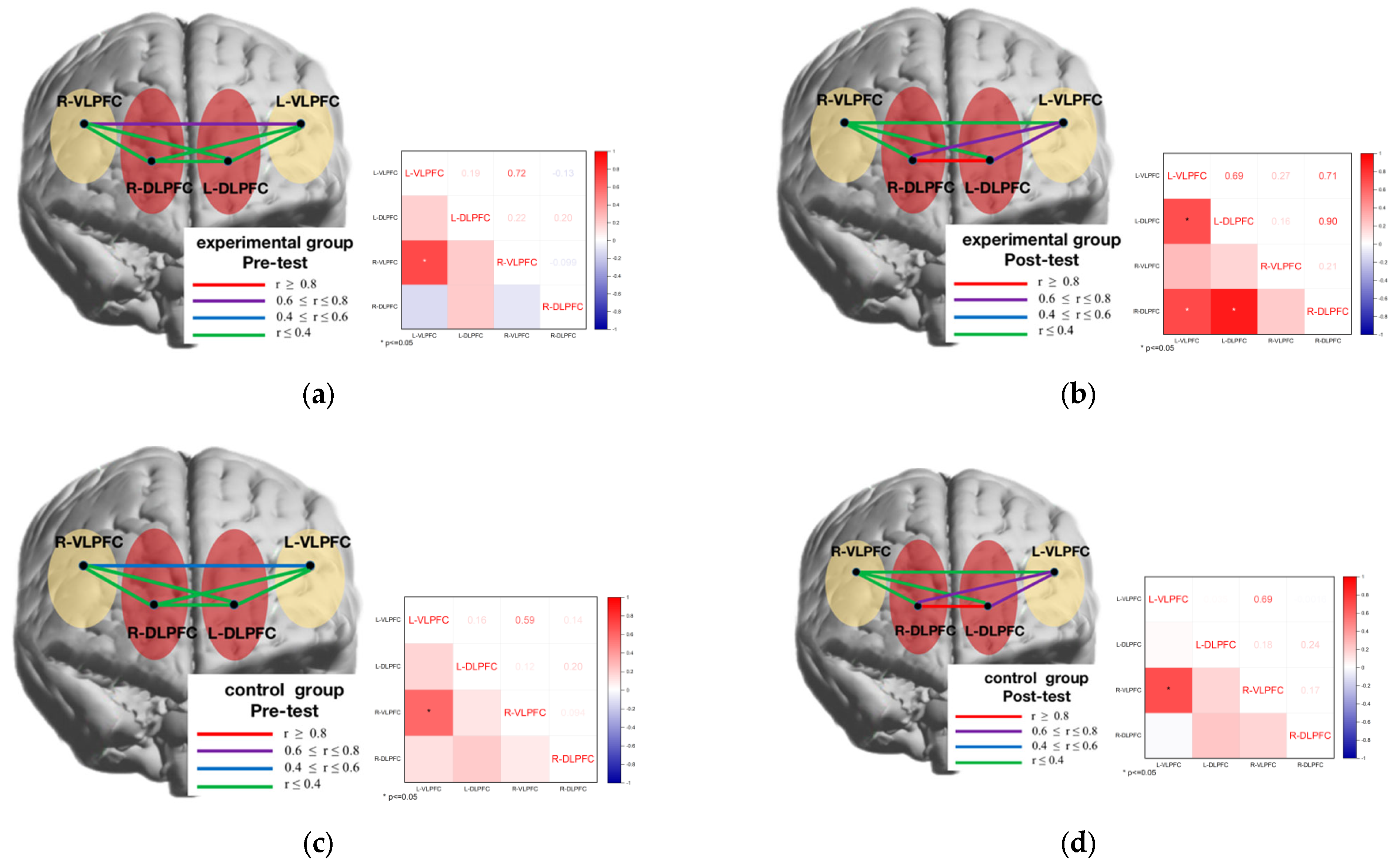

| Weeks | Course Content | Teaching Content |
|---|---|---|
| Pre-test | Spatial memory test | |
| 1–4 | Drawing exercise | Purpose of training: to deepen students’ understanding of orienteering map symbols and colors. Practice: master map symbols, colors, contours and checkpoint description sheets. Give students a map with blank areas and ask them to fill in the blanks according to the field situation. |
| 5–8 | Exercise in map memorization (simple) | 1. Purpose of training: to develop students’ ability to memorize routes on campus. 2. Practice: a point-memory relay race on campus, by setting up point information of different difficulties for memory punching (number of single punches, number of target interference points). |
| 9–12 | Exercise in map memorization (complex) | 1. Purpose of training: to develop students’ ability to memorize routes in the field. 2. Time: point-memory training in the field, by setting up point information at different levels of difficulty for memory punching (number of single punches, number of target disturbance points). |
| Post-test | Spatial memory test |
| Source of Variation | ACC (%) | RT (ms) | ||
|---|---|---|---|---|
| F | η2 | F | η2 | |
| Group | 1.198 | 0.025 | 1.802 | 0.038 |
| Period | 1.981 | 0.041 | 7.083 * | 0.133 |
| Period × group | 10.619 ** | 0.188 | 8.661 ** | 0.158 |
| Source of Variation | ACC (%) | RT (ms) | ||
|---|---|---|---|---|
| F | η2 | F | η2 | |
| Gender | 0.362 | 0.016 | 4.932 * | 0.183 |
| Period | 13.907 ** | 0.387 | 32.648 ** | 0.597 |
| Period × gender | 4.288 * | 0.230 | 3.965 * | 0.176 |
| Source of Variation | L-VLPFC | R-VLPFC | L-DLPFC | R-DLPFC | ||||
|---|---|---|---|---|---|---|---|---|
| F | η2 | F | η2 | F | η2 | F | η2 | |
| Group | 0.012 | 0.001 | 0.001 | 0.001 | 17.691 ** | 0.278 | 6.557 * | 0.125 |
| Period | 1.074 | 0.023 | 0.847 | 0.018 | 11.410 ** | 0.199 | 2.661 | 0.055 |
| Period × group | 0.001 | 0.001 | 0.056 | 0.001 | 12.247 ** | 0.210 | 11.183 ** | 0.196 |
| Source of Variation | L-VLPFC | R-VLPFC | L-DLPFC | R-DLPFC | ||||
|---|---|---|---|---|---|---|---|---|
| F | η2 | F | η2 | F | η2 | F | η2 | |
| Gender | 0.028 | 0.001 | 0.030 | 0.001 | 0.009 | 0.001 | 0.941 | 0.041 |
| Period | 0.431 | 0.019 | 0.239 | 0.011 | 22.563 ** | 0.507 | 11.448 ** | 0.507 |
| Period × gender | 0.049 | 0.002 | 0.973 | 0.042 | 4.331 * | 0.164 | 0.128 | 0.006 |
| Period | L-VLPFC | R-VLPFC | L-DLPFC | R-DLPFC | ||||
|---|---|---|---|---|---|---|---|---|
| Male | Female | Male | Female | Male | Female | Male | Female | |
| Pre-test | 0.307 | 0.377 | 0.171 | 0.406 | −0.035 | −0.154 | −0.362 | 0.287 |
| Post-test | −0.179 | −0.215 | −0.037 | 0.074 | −0.602 * | −0.255 | −0.651 * | −0.732 ** |
Publisher’s Note: MDPI stays neutral with regard to jurisdictional claims in published maps and institutional affiliations. |
© 2022 by the authors. Licensee MDPI, Basel, Switzerland. This article is an open access article distributed under the terms and conditions of the Creative Commons Attribution (CC BY) license (https://creativecommons.org/licenses/by/4.0/).
Share and Cite
Bao, S.; Liu, J.; Liu, Y. Shedding Light on the Effects of Orienteering Exercise on Spatial Memory Performance in College Students of Different Genders: An fNIRS Study. Brain Sci. 2022, 12, 852. https://doi.org/10.3390/brainsci12070852
Bao S, Liu J, Liu Y. Shedding Light on the Effects of Orienteering Exercise on Spatial Memory Performance in College Students of Different Genders: An fNIRS Study. Brain Sciences. 2022; 12(7):852. https://doi.org/10.3390/brainsci12070852
Chicago/Turabian StyleBao, Shengbin, Jingru Liu, and Yang Liu. 2022. "Shedding Light on the Effects of Orienteering Exercise on Spatial Memory Performance in College Students of Different Genders: An fNIRS Study" Brain Sciences 12, no. 7: 852. https://doi.org/10.3390/brainsci12070852
APA StyleBao, S., Liu, J., & Liu, Y. (2022). Shedding Light on the Effects of Orienteering Exercise on Spatial Memory Performance in College Students of Different Genders: An fNIRS Study. Brain Sciences, 12(7), 852. https://doi.org/10.3390/brainsci12070852






